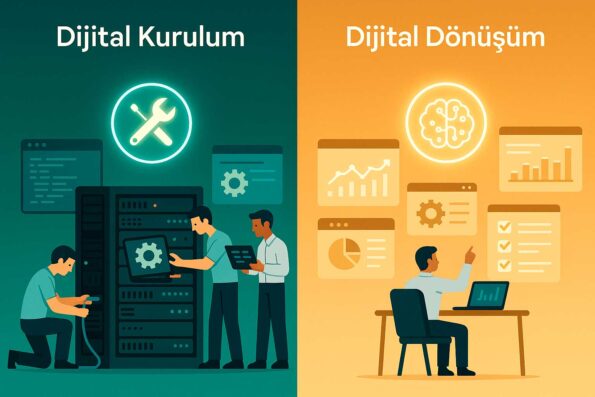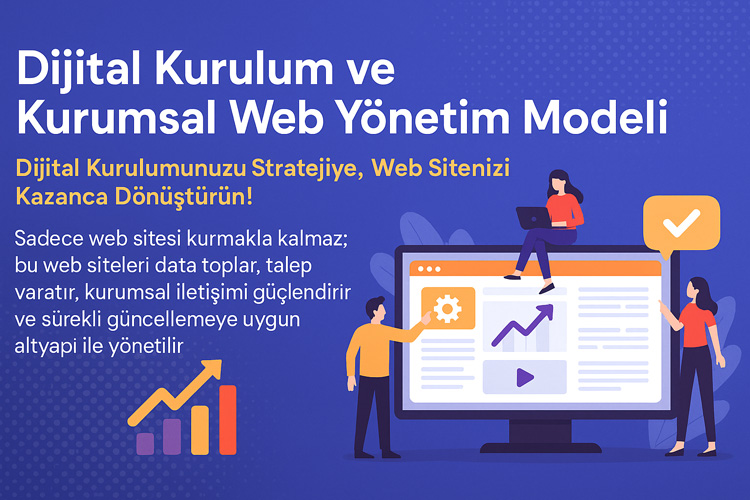Every business looking to embark on a digitalization journey asks the same question: Digital transformation or digital installation? These two concepts are often confused, but the differences between them are critical to your company’s future. Making the wrong choice can lead to wasted time and budget.
Many SMEs and medium-sized businesses hesitate to embark on this journey due to the cost and cultural pressures associated with comprehensive processes like digital transformation. However, not every business has the same digitalization strategy. Choosing the right model for your needs can put you a few steps ahead of the competition.
In this article, we will explain in detail the differences between digital transformation and digital installation, explaining which one your business needs in which situation, application scenarios, and what to consider when making a decision, using examples. 🚀

İçindekiler
ToggleWhat are Digital Transformation and Digital Installation?
This is often where the initial confusion begins when starting digitalization. Digital transformation is not just an investment in software or hardware; it’s the redefinition of the entire way of doing business with digital tools. Digital installation is the foundational beginning of this transformation.
Both processes involve technological tools. However, one is a strategic and cultural change, while the other is an operational and technical implementation. 👇
What is Digital Installation? You can review our article, “Where Should You Start in Your Company?”.
Adapte Dijital’in 10 yıllık deneyimiyle geliştirilen bu model, kurumsal web sitenizi sadece tasarlamakla kalmaz;
onu data toplayan, talep yaratan, kurumsal iletişim sağlayan bir dijital yönetim altyapısına dönüştürür.
Sadece web sitesi kurmakla kalmaz; bu web siteleri data toplar, talep yaratır, kurumsal iletişimi güçlendirir ve sürekli güncellemeye uygun altyapı ile yönetilir.
Definition of Digital Transformation
Digital transformation means reengineering all workflows, from customer experience to internal processes. Technologies such as CRM, ERP, automation systems, data analytics, and artificial intelligence are used in this transformation. So, it’s not just about changing the tools, it’s about transforming the company’s philosophy.
Digital Setup Definition
Digital setup is the installation of technical building blocks such as email systems, cloud file structure, basic security layers, website, and social media. This is the first and most critical step of the transformation, but it doesn’t always mean a complete transformation.
The Reason for the Confusion Between the Two Concepts
When businesses say “going digital,” they’re usually talking about installation processes, not digital transformation. Failure to understand this difference can lead to misdirected resources.
Which Should Be Preferred in Which Situation?
While a digital setup is sufficient for a startup, an established SME needs to develop a transformation strategy for competitive advantage. The process you’re in determines your decision. 📌
👉 When you understand these differences, you can plan the best course of action for your business.
When is a Digital Setup Enough?
Many businesses begin their digital transformation with limited budgets. In this case, the word “transformation” can be intimidating. However, transformation isn’t always necessary; Sometimes a digital setup is enough to grow a business.
A digital setup is a scalable startup model, especially for startups or SMEs taking the first step into digitalization.
For Small Businesses to Jump Start
You can start with an internet presence, basic security, file management, and customer communication infrastructure. In other words, the setup is building the basic digital muscles.
Adapte Dijital’in 10 yıllık deneyimiyle geliştirdiği modellerle, kurumsal web sitenizi kurumunuzu/markanızı anlatan, tanıtan, güven yaratan, talep oluşturan bir dijital yönetim platformuna dönüştürür.
Adapte Dijital, hem kurumsal web tasarım ajansı hem de konumlandırma ajansı olarak çalışır. Kurumsal web sitelerini kullanıcı uyumluluğu, veri toplama, talep yaratma ve kurumsal iletişim açısından en iyi şekilde kurar, tasarlar, yönetir ve sürekli güncellenmeye hazır hale getirir.
Installation as a Preparatory Step for Transformation
The installation process also provides a testing ground for digital transformation. The team gets acclimated, and digital discipline develops. This process provides the foundation and confidence for larger steps in the future.
For Rapid Scalability
Thanks to cloud technologies, even a small installation can easily grow over time. In other words, it’s possible to evolve from installation to transformation.
ROI of Installation
The efficiency and speed achieved at low cost show the return on investment of a digital installation within a few months. The digitization of manual processes, in particular, provides a 20-30% increase in employee productivity. 📈
👉 If your company is new or weak in digital, starting with the setup is a smart step.
When Does Digital Transformation Become Mandatory?
As competition intensifies, customer expectations change, and industries become more intertwined with digital tools, digital transformation is no longer a luxury, It becomes a necessity.
At this point, transformation becomes a strategy that touches not only technology but also corporate culture, workflows, and leadership.
Today, digital transformation is becoming essential not only for gaining competitive advantage but also for the sustainability of operations. Especially for businesses experiencing a lack of technological infrastructure, slow manual processes, and data loss, transitioning to digital is no longer an option; it is an inevitable necessity. If your company cannot respond to customer demands instantly, is experiencing service disruptions due to system errors, or if competitors have already begun to differentiate themselves with digital tools, the time has come for transformation. 🕒
Legal regulations also trigger the need for transformation in digital archiving, remote access, or cybersecurity. For example, data security regulations like KVKK can put SMEs with manual record keeping systems at serious risk. Furthermore, the post-pandemic hybrid working order has made digital documentation and process automation essential. Delaying this transition means increasing costs and losing opportunities. 💼
If your business wants to be resilient and adaptable to the future, digital transformation should start today. Don’t wait for the perfect time to take action; Because your competitors have already started.
When Customer Experience Goes Digital
Customers now want to do everything online. Purchases, support, returns, reviews, suggestions… Conversion allows us to meet these demands. The digitalized customer experience can attract customer attention faster with personalized content. Thanks to chatbots, CRM systems, and AI-powered analytics, it becomes possible to connect with customers at the right time through the right channel. This not only increases satisfaction but also customer loyalty and repeat purchase rates. 🎯
When Data-Driven Decision Making Is Essential
Making the right decisions without data analytics becomes impossible. Digital transformation enables the collection, interpretation, and actionability of this data. Data-driven decision-making plays a critical role in gaining competitive advantage not only for large companies but also for SMEs. For example, optimizing campaign durations based on weekly analysis of sales data both reduces costs and increases conversion rates. Similarly, regular reporting of customer feedback can directly identify improvements to products or services. Data-driven forecasting models allow you to anticipate future risks and opportunities. This approach helps your business navigate uncertain environments.It allows you to move your business forward on a more solid foundation. 📊
When Operational Inefficiencies Increase
Disconnections between different departments, delays in information flow, repetitive tasks… All of these can be eliminated with transformation. These types of inefficiencies often manifest themselves in repetitive manual tasks, inaccurate data entry, and disconnections between departments. Disruptions in inventory management, invoicing, and customer service processes, in particular, lead to lost time and increased costs. Integrating these processes with digital transformation systems minimizes errors while making processes traceable and optimized. This results in both labor savings and a noticeable increase in customer satisfaction. ⚙️
If Competitors Have Transformed, So Have You
If digitalized competitors are gaining ground in the market, it’s essential for you to keep pace. Otherwise, market share loss is inevitable. ⚠️When your competitors go digital, they transform not only their processes but also their customer expectations. This makes your old service delivery methods seem inadequate and outdated. Digitally strong competitors gain market advantage through speed, accessibility, and data-backed decisions. If you don’t take action, you unknowingly increase the risk of being outcompeted. 🔍
👉 If you see these signs, conversion is inevitable.
How to Build a Transition Strategy Between Digital Setup and Conversion
The transition from setup to conversion doesn’t happen overnight. A strategic transition plan should be prepared, and a roadmap should be drawn in stages.
In this process, both team adaptation and technical capacity must be enhanced. To manage this transition, you must first objectively analyze your current digital capacity. Clarifying which processes have been automated with the digital installation and which are still manually operated creates a robust roadmap. Next, it’s necessary to determine the cultural adaptation steps required for the transformation, as the human factor is as decisive as the technology in this transition. Defining measurable goals for each step and monitoring these goals ensures the sustainability of your strategy. This way, you can build a strategic transformation on the solid foundation of a digital installation. ✅
Step-by-Step Migration Plan
- Installation Must Be Completed: Web infrastructure, data management, and security systems must be working.
- Needs Analysis Must Be Conducted: Which workflows have bottlenecks?
- Priority Processes Should Be Determined: Automation or CRM can be the first step.
- A Training Plan Should Be Prepared: The team should be prepared for digital competence.
Team Roles and Responsibilities
Every team member should take responsibility during the digital transformation transition. A clear division of duties should be established between departments such as marketing, IT, and human resources. Each team member’s role and role in the digital transformation process should be clearly defined. The coordination of not only the IT department but also all departments, from marketing to human resources, plays a critical role in this process. Data managers, in particular, should be responsible for producing analyses that ensure the sustainability of the digital infrastructure. A digital transformation leader should also be appointed to ensure transparency throughout the entire process. This clear structure ensures that each team member knows their current status in the process, and achieving digital goals becomes much more efficient. ✅
KPI-Based Progress
The transition plan should be tied to success criteria: measurement should be done using indicators such as customer satisfaction, transaction time, and data accuracy.
Adapting to Corporate Culture
Transition success depends on cultural transformation, not technical transformation. Communication strategies should be developed to ensure the team embraces this process. 🤝
👉 The transition process should be planned and managed like change management.
Common Mistakes: Things to Consider During Digital Setup and Transformation
Digitalization can be exciting; however, some critical mistakes can cause businesses to lose both time and money. The biggest danger is that many of these mistakes are made unknowingly.
Many businesses invest in technology without developing a strategy or initiate transformations without involving their team. However, the success of digitalization lies not only in the software used but also in how the process is planned, executed, and adopted. 🚫 Hastily selecting digital tools can lead to system incompatibilities and data loss in the long run. During the installation or transformation process, not only technological but also cultural adaptation should be planned. Many companies encounter internal resistance by leaving employee training until the very end of the process. Furthermore, not defining measurement metrics from the outset makes it difficult to assess the impact of the investment. Therefore, every step should be supported by a strategic roadmap and sustainability goals. 🚧
Starting Without a Strategy
Many businesses set out with the sole purpose of “going digital” and don’t create a clear strategy for what they’re doing and why. This is like embarking on a journey without a route. The result: failed projects despite the budget spent.
📌 Tip: First, conduct a needs analysis, then create a roadmap. If this order isn’t followed, the transformation turns into an unplanned pileup.
Not Involving the Team in the Process
Digital transformation may be a senior management decision, but the implementation is on the ground. If teams aren’t included in the process, resistance develops. New systems aren’t used or implemented effectively.
💡 Reminder: Digitalization is a human and cultural project. A training and communication plan is essential.
Too Much Technology, Too Little Focus
Trying every new tool leads to confusion, not success. Data integrity is compromised across platforms, and employees don’t know what to do and where.
⚙️ Warning: Starting with a few but effective tools is the best approach. It’s possible to expand it modularly later.
Forgetting to Track Performance
If the process isn’t tracked after the installation or conversion, success can’t be measured. If a KPI isn’t set, the question “what worked?” remains unanswered.
📈 Recommendation: Every digital step should have measurable goals and metrics. Otherwise, the return on investment will be uncertain.
👉 Recognizing and preventing these mistakes will ensure the sustainability of your digitalization.

Decision Guide for SMEs: Installation or Conversion?
Digitalization for SMEsThe process often begins with the question, “Where should we start?” However, the real question is, “Should we implement a digital installation or a transformation?” This decision should be made based on the business’s current digital maturity level, goals, and resources. For SMEs, the digitalization journey should be customized according to budget, human resources, and business volume. The installation process is more suitable for those looking to build a digital structure from scratch, while transformation involves renewing and integrating existing systems. A clear understanding of this difference is critical for proper timing and resource allocation. Furthermore, regardless of the process you choose, advancing with metrics aligned with your goals directly impacts success. Both paths have their advantages and challenges; the important thing is to take the step your business is ready for. ✅
Digital installation is the best approach for businesses taking the first step toward digitalization. The goal here is to establish the basic digital infrastructure, migrate manual processes to digital, and begin working with data. Systems such as ERP, CRM, and cloud-based solutions are implemented.
Digital transformation is suitable for businesses that already have a digital infrastructure but want to optimize it, make it more agile and integrated. The goal of the transformation is to increase efficiency, accelerate decision-making processes, and transition to new business models. ⚙️
SME Profile Suitable for Setup
- Does not yet have the technological infrastructure
- Works with Excel, paper, and manual systems
- Uses a folder system instead of a data center
- First-time ERP, CRM, and automation systems installation
🎯 For these businesses, the Digital Installation Model™ is the ideal starting point. The priority is to establish a system, train teams, and create a digital landscape.
SME Profile Suitable for Digital Transformation
- Uses systems such as ERP and CRM, but inefficiently
- Lack of integration between processes
- KPIs are tracked not used, data not used
- Wants to increase competitiveness
🚀 The 5+1 Digital Adaptation Plan is recommended for these businesses. The goal: to achieve true digital transformation by optimizing the current structure.
Things to Consider in the Decision Process
- Conduct an internal analysis: Know where you stand.
- Conduct a resource and budget analysis: How much can you invest?
- Set a goal: What do you want to solve in the short term?
- Get consulting: Expert advice saves you from mistakes.
📌 The best way for undecided SMEs is to start with a simple digital setup and prepare for transformation.
Timing of Investment: When is the Best Time for Installation and Transformation?
Timing plays a critical role in SMEs’ success in the digitalization process. Rushing or constantly postponing digital installation or transformation investments can lead to both wasted resources and a loss of competitiveness. But when is the right time?
First sign: If processes are manual, data tracking is lacking, or customer complaints have increased, digital installation is inevitable. However, if you have digital tools but low usage and integration problems among employees, it’s time for transformation. ⏱️Right timing is critical to the success of digital investments.It plays a crucial role. Investing during periods of accelerated sectoral change and agile customer demand provides a competitive advantage. Investments made before economic fluctuations can reduce costs in the long run. A period of increased business volume is preferable for installation; however, periods of increased manual workload and bottlenecks in existing systems are the most suitable for transformation. 📈 Seizing this strategic window not only initiates digitalization but also ensures the sustainability of your business.
Economic recessions are also valuable for investment. This is because business volume decreases during these periods, providing time to build infrastructure. At the same time, digitalized businesses can turn a crisis into an opportunity. Especially when supply chain disruptions occur, gaining visibility through digital systems makes a big difference.
Critical Triggers for Digital Transformation Investment
- Decision to enter a new market
- Rapidly increasing number of customers
- Inefficient human resources
- Incorrect orders, stock issues
- Government incentives or support packages
📊 “When the timing is right, investment turns into profit. The right analysis, the right system, and the right moment…”
Suitable for Installation Time
- Before opening a new branch
- Before establishing a new team
- Just before the need for integration begins
The Right Time for Digital Transformation
- When software updates are planned
- When existing ERP/CRM systems start to cause problems
- When competition increases and growth opportunities exist
📌 As Adapte Dijital, our recommendation: Installation and conversion It’s important to make your decision based not only on the current situation but also on your vision for the future. Good timing brings good conversions.
How to Calculate Return on Investment (ROI) in Digital Installation and Transformation?
Investing in a digital infrastructure or transformation process doesn’t just mean spending. Measuring the return on investment (ROI) is just as important for decision-makers as the investment itself. However, calculating ROI in digital investments is a bit different and more comprehensive than traditional investments. So, how do you do this? When calculating ROI in a digital installation process, focusing solely on software or hardware costs is insufficient. Indirect returns such as time savings, workforce efficiency, and increased customer satisfaction should also be considered. The speed achieved through process automation, in particular, quickly amortizes costs. The ability to make decisions supported by data gained after digital installation also increases the competitiveness of the business. Therefore, ROI analysis should consider not only “what we spent,” but also “what we gained.”
Digital ROI is typically calculated with the following formula:
(Net profit after digital system – investment cost) / investment cost
However, there are many hidden benefits to consider:
- Time savings
- Operational efficiency
- Increase in errors
- Reduction in errors
- Increase in customer satisfaction
- Improvements in employee engagement
🎯 These benefits are not always directly related toIt can’t be put to the test, but it provides a significant cost advantage in the long run.
What to Consider When Calculating ROI?
- Clarify Investment Items: Detail all expenses such as software, hardware, integration, training, and consulting.
- Determine KPIs: Sales increase, order turnaround time reduction, customer retention Choose measurable metrics like the ratio.
- Choose the Right Timeframe: Digital transformation investments are not measurable in the short term, but generally within 6–18 months.
- Note Indirect Benefits: Also note effects such as reputational growth, first-mover advantage, and reduced staffing requirements.
An Example ROI Scenario
- Investment: 500,000 TL (including ERP installation, training, and consulting)
- Savings + income increase at the end of the first year: 900,000 TL
- ROI = (900,000 – 500,000) / 500,000 = 80%
In this case, the investment will pay for itself in less than a year. This rate can represent a much faster return than marketing or physical production investments.
📌 At Adapte Dijital, we recommend: Evaluate digital ROI calculations based on strategic value, not just budget. Today’s investment determines tomorrow’s competitive advantage.

Strategic Roadmap for Successful Digital Deployment and Transformation
Every company that wants to digitalize must first clarify “where to start.” Digital deployment and transformation is not a technology project, but an organizational change journey. Therefore, a pre-planned, customized roadmap created with the participation of all stakeholders is essential. Achieving success in the Digital Transformation process is not limited to simply integrating technological tools. This transformation also encompasses a cultural shift, leadership vision, and sustainable business models. 🎯 For the success of Digital Transformation, clear goals must first be set, and the steps to achieve these goals must be supported by a digital deployment strategy. Challenges that may be encountered during Digital Transformation must be anticipated, and flexibility must be ensured at every step. For SMEs in particular, Digital Transformation is the key to increasing competitiveness and taking firm steps into the future. Digital Transformation is no longer an option; it is a strategic imperative. 🔁
So how is this roadmap created? 🚀
1. Analyze the Current Situation
The first step is to identify your business’s current digital capacity and bottlenecks.
- Which business processes are still being handled manually?
- How is data collected and managed?
- Is there integration between systems?
🔍 This analysis provides a clear picture of your strengths and weaknesses.
2. Define Clear Goals
Digitalization is a means, not an end. Therefore:
- Reduce operational costs?
- Improve customer experience?
- Get ahead of the competition?
🎯 Each goal determined influences the technology selection and path plan.
3. Prioritization and the MVP Approach
Digitalizing all processes at once is not sustainable. Instead:
- Select the processes that experience the most problems.
- Launch pilots with a Minimum Viable Product (MVP) approach.
- Build trust in the organization by achieving short-term successes.
4. Technology and Workforce Alignment
A good digital roadmap should be built not only on software and hardware, but also on human resources and competencies.
- A training plan should be created.
- Task definitions appropriate to new roles should be created.
- Change management processes should be designed.
💡 Reminder: Every technology choice should be compatible with the company culture and structure. Success comes from digital solutions tailored to your company, not ready-made systems.
Why is Digitalization Important? We recommend reviewing our article, “5 Critical Reasons for SMEs.”
How to Build a Transition Strategy Between Digital Installation and Transformation?
While digital installation provides a foundation, digital transformation is the organizational renewal built upon this foundation. However, many companies confuse these two steps or implement them in the wrong order. However, the right strategic transition can both increase efficiency and reduce transformation costs.
So how should this transition strategy be designed? ⚙️
1. Correctly Position the Infrastructure That Comes with the Installation
Installation is not just about technology; It’s a process, a people-based, and an organization.
The steps taken at this stage form the framework of the transformation:
- ERP systems,
- Automation panels,
- Structures such as API integrations lay the groundwork for transformation projects.
💡 Every decision made during installation directly impacts future transformation steps.
2. Start Change Management Early
Digital transformation is not only a system change, but also a behavioral change.
Therefore, during the installation process:
- Training plans should be initiated,
- Internal communication should be increased,
- Employees’ digital competencies should be measured.
📣 Instead of “First set up the system, then explain it,” the approach of “learn together throughout the process” should be adopted.
3. Integrate KPI and Data Tracking Systems
Digital transition must be measurable.
Therefore:
- Each installation component should match a KPI,
- Each conversion step should be supported by data,
- Each metric should inform the next step.
🔎 Transformation without data is like a ship without a compass.
4. Develop a Flexible and Feedback-Friendly Plan
The transition strategy should be designed not with rigid boundaries, but with a learning system approach.
- User feedback should be obtained after each step.
- Technology should be updated if necessary.
- Adaptation capability should be part of the plan.
🚧 Digitalization is not a static process, but a constantly evolving process. Plans should be prepared with this understanding.
How to Build Digital Infrastructure? Step-by-Step Implementation Guide (2025).
Common Mistakes: Things to Consider During Digital Setup and Transformation
While digital setup and transformation processes offer businesses great opportunities, this potential may not be fully realized due to some common mistakes. Missteps can lead to both lost time and significant costs. So, what are the most common mistakes in this process? And how can they be avoided?
1. Focusing on Technology and Forgetting Strategy
Many organizations view digitalization solely as a software or hardware investment.
However, technology without a strategy is merely a tool.
- Before the digitalization process begins,
- Clear goals, roadmaps, and performance indicators must be defined.
📌 Otherwise, even the best tools will not deliver the expected efficiency.
2. Ignoring User Training
If employees can’t use new systems effectively after they’re installed, the entire investment will be wasted.
Lack of training leads to user resistance and loss of productivity.
- Training programs should be planned in parallel with system installation.
- Continuous support and guidance should be provided.
🎯 Remember: “People make things work, not systems.”
3. Ignoring Integration and Compatibility Issues
When new digital tools don’t integrate with existing systems:
- Data transfer becomes difficult,
- Processes become fragmented,
- Workflow slows down.
🔄 Therefore, API integrations, data structures, and platform compatibility should be tested in advance.
4. Not Tracking ROI and Processes
Continuing without measuring the benefits of digitalization can blind a business.
- Return on investment (ROI) should be analyzed at every step,
- Performance indicators and measurements should be performed regularly.
📊 This way, processes can be optimized when necessary and risks can be identified early.
Decision Guide: Which One Should You Choose at Which Stage?
Digital deployment and digital transformation, while seemingly similar concepts, actually play very different roles depending on the company’s digital maturity level. So, where is your business currently at? And which one should you choose?
🚀 Targeting digital transformation at this stage is like building on a systemless structure.
Intermediate Level: Transitioning to Conversion After Installation
If you already have a certain digital infrastructure but want improvement in efficiency, integration, and innovation, you can now move on to the transformation phase.
Digital transformation is at this point:
- Your business model
- It enables the redesign of the customer experience,
- It enables the adaptation of new technologies (AI, IoT, Big Data).
📌 The transformation at this stage is a strategic leap built upon the established structure. - Incomplete infrastructures are quickly established,
- At the same time, operational processes are digitalized,
- Time-saving priority steps are identified.
🔁 The important thing here is to determine which step comes first with the “priority matrix.” - Which of your processes are still manual?
- How effectively can you use your data?
- What do you need to digitize your customer experience?
- Technical foundations of digital installation,
- The strategic dimension of digital transformation,
- The question of which model should a business choose at which stage,
- Topics such as application scenarios and transition strategies are detailed.
💡 The article not only provides information but also has a consulting structure that accelerates and clarifies decision-making processes. - Real installation case studies
- Frequently used digitalization errors
- Transformation plans specifically for SMEs
- Digital infrastructure optimization tips
- And includes field experience from the Adapte Digital team.
Crisis or High Growth Situations: Implement a Hybrid Approach
Some businesses In times of crisis or rapid growth, both installation and transformation are needed.
In such cases, a hybrid model is required:
Ask 3 Questions for Strategic Decisions
The answers to these questions clearly reveal whether you should install or convert.
📘 About This Content
This content was prepared to clarify the dilemma “Digital Installation vs. Digital Transformation”, which is the most common dilemma faced by SMEs and medium-sized enterprises during the digitalization process.
It aims to provide a detailed guide, especially for managers and decision-makers who want to digitize their businesses but don’t know where to start.
All information used in this article is based on strategic frameworks such as Adapte Dijital’s Digital Installation Model™ and 5+1 Digital Adaptation Plan.
In this context, the content:
👉 Adapte Dijital is a consulting agency specializing in digital transformation and deployment.
It provides digital infrastructure deployments, transformation strategies, and sustainable digital management solutions for many brands, from SMEs to large enterprises.
If you’d like to learn more, see application examples, and hear expert advice, you can check out our Adapte Dijital YouTube channel:
🎥 YouTube.com/@adaptedijital
Content waiting for you there:
Remember: Digitalization is not a choice, it is a necessity.
But it is our job to make this process meaningful, applicable, and sustainable for you.
🔗 All concepts mentioned throughout this article are part of our “Digital Installation Model™” content series.
To access all the topics in this series, please visit our website or follow us on social media. https://www.instagram.com/adapte_dijital/







